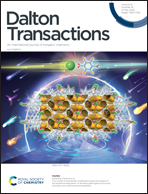Which is the real oxidant in competitive ligand self-hydroxylation and substrate oxidation—a biomimetic iron(ii)-hydroperoxo species or an oxo-iron(iv)-hydroxy one?†
Abstract
Nonheme iron(II)-hydroperoxo species (FeII-(η2-OOH)) 1 and the concomitant oxo-iron(IV)-hydroxyl one 2 are proposed as the key intermediates of a large class of 2-oxoglutarate dependent dioxygenases (e.g., isopenicillin N synthase). Extensive biomimetic experiments have been exerted to identify which one is the real oxidant and to reveal the structure–function relationship of them, whereas the mechanistic picture is still elusive. To this end, density functional theory (DFT) calculations were performed to systematically study the mechanistic details of ligand self-hydroxylation and competitive substrate oxidation by these two species supported by a tridentate ligand Fe(TpPh2)(benzilate) (TpPh2 = hydrotris(3,5-diphenylpyrazole-1-yl)borate). The calculated results revealed that the structure and the conversion of the FeII-(η2-OOH) complex 1 are obviously different from the ferric FeIII–OOH one. The orientation of the Fe–OOH moiety of 1 is side-on, while that of the ferric FeIII–OOH species is end-on. The conversion of 1 to the high-valent iron-oxo species is exothermic, while the conversion of the ferric FeIII–OOH species to the high-valent species is endothermic. Thus, the sluggish 1 does not act as the oxidant and readily decays to the robust 2. The activation energy of intramolecular ligand self-hydroxylation in 2 is 14.8 kcal mol−1 and intermolecular substrate oxidations (e.g., thioanisole sulfoxidation) with a lower barrier show a strong inhibiting ability toward ligand self-hydroxylation, while those with a higher barrier (e.g., cyclohexane hydroxylation) have no effect. Our theoretical results fit nicely with the experimental observations and will enrich the knowledge of the metal–oxygen intermediate and play a positive role in the rational design of new biomimetic catalysts.



 Please wait while we load your content...
Please wait while we load your content...